- VS Gaitonde
- Ram Kumar
- Akbar Padamsee
- Amrita Sher-Gil
- Vanita Gupta
- Smita Kinkale
- Ratnadeep Adivrekar
- Tathi Premchand
- Nilesh Kinkale
- Prabhakar Kolte
- Chintan Upadhyay
- Prabhakar Barwe
- Shankar Palsikar
- Yashwant Deshmukh
- Prabhakar Kolte
- Sanchita Sharma
- Prakash Waghmare
- Ranjit Hoskote
- Premjish Achari
- Pankaja JK
- Contact
Tuesday, 30 April 2024
Nature Morte Mumbai: LORENZO VITTURI: METAMORPHOSIS
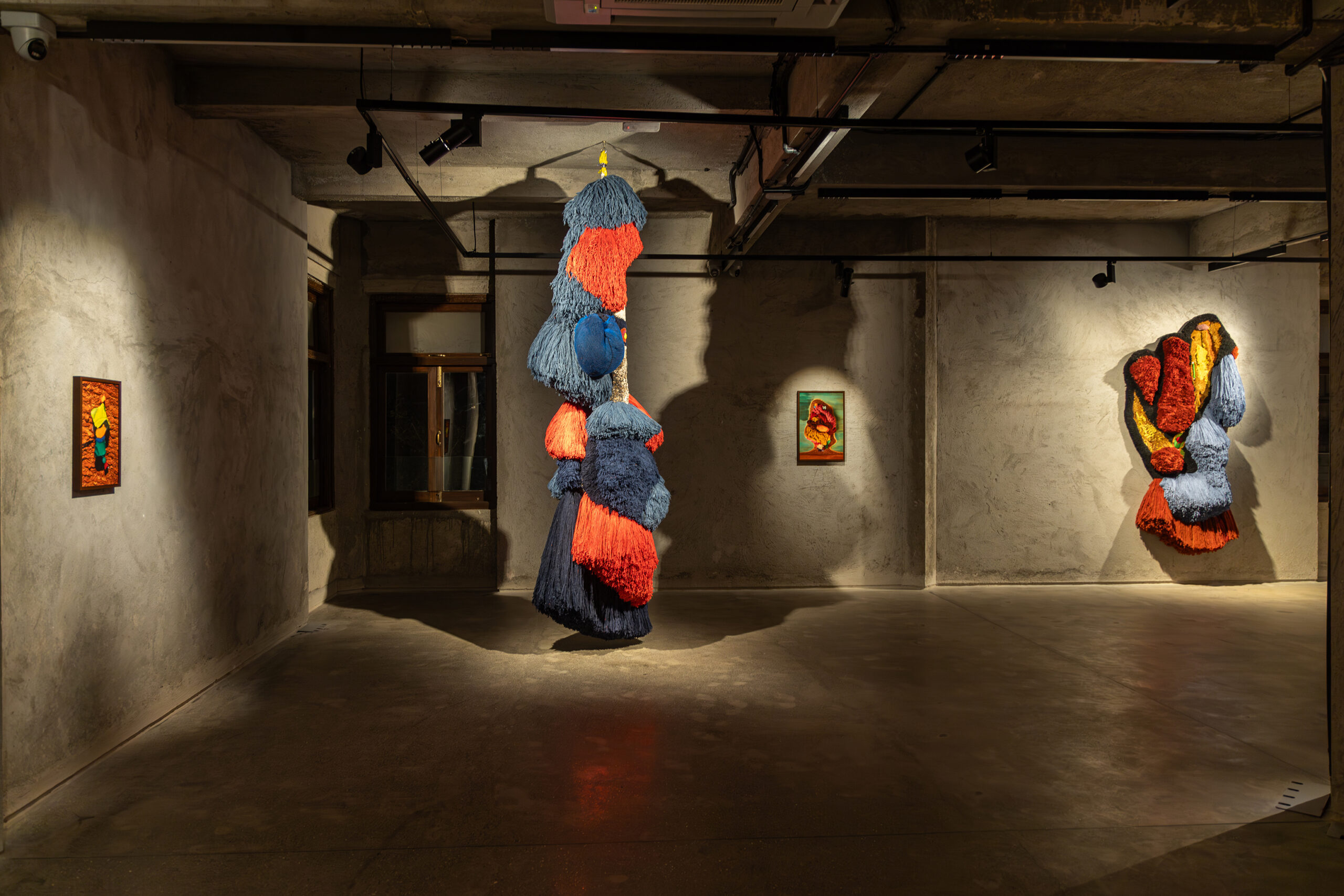
Nature Morte is pleased to present a new body of work by the artist Lorenzo Vitturi.
This is our second show with the artist having presented his solo show in our New Delhi gallery in 2022.
The fog envelops the lagoon and the architecture in the distance. I walk along the canal with Lorenzo after leaving his studio in Murano. We pause for a moment to look around. In the cold mist, the edges – of land, buildings, thoughts – loosen up. A flock of birds interrupts the opaque sky, drawing an endless line, a space with no frontier. This all feels fleeting and, at the same time, eternal. “It is the substance of an image”, says Lorenzo, as if to frame this vision in time.
It is this felt presence of the image, its corporeal dimension, and the tension between what is material and impermanent that pervades Lorenzo’s oeuvre. Much of his photographic and sculptural work emerges from everyday interactions and dialogues with local communities and artisans. It also results from the careful study, manipulation, and combination of materials that he selects based on their provenance as well as their cultural and historical narratives. In particular, the selection presented for “Metamorphosis” at Nature Morte in Mumbai traces back to the artist’s biographical roots in Italy and Peru, while unveiling the result of collaborations with artisans in Murano, Italy, at the Jaipur Rug Foundation in India, and indigenous communities in Chinchero, Peru. To enter the landscapes embedded in these works is an act of balance and reframing. From gigantic soft sculptures floating from above, to small and delicate still-lifes containing fractal patterns and geometries, the works play on different scales. The oversized dimensions and softness of the pieces invite us to compare our bodies with other volumes, our material with that of the sculptures, while pointing to other, beyond-human forms.
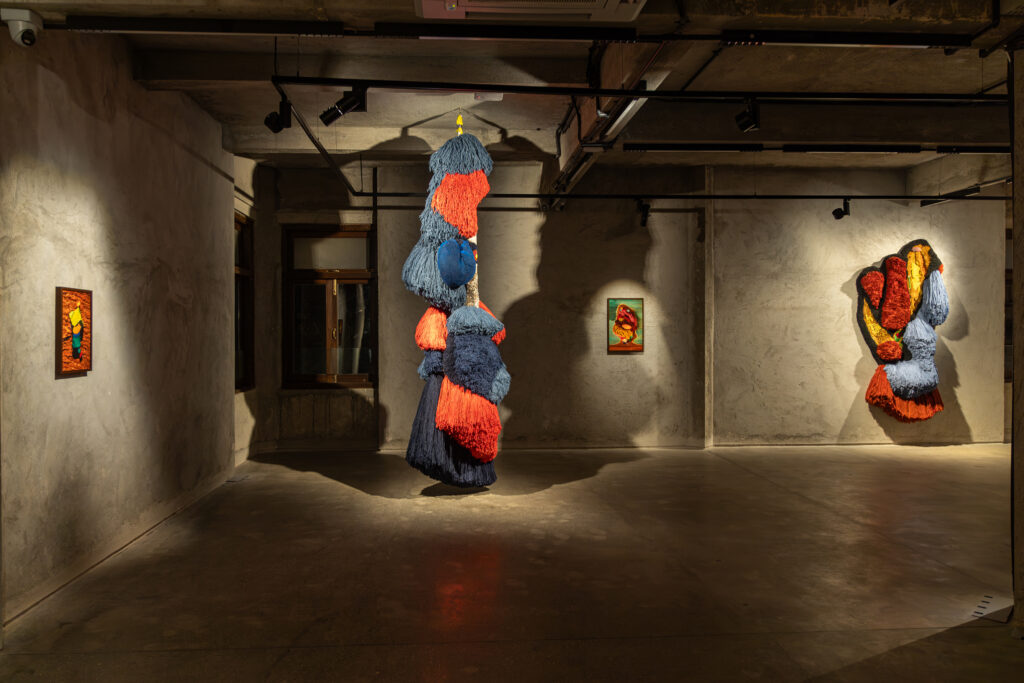
Murano-fused glass, Peruvian yarns, fishing nets, Indian hand-made rugs, eucalyptus wood, cocaine leaves: the materials become the silent protagonists that tell multi-layered stories about lived experience. These experiences are not only those of Lorenzo and the artisans involved in making the work, but also of those who look at the forms and see parts of themselves in them. To accompany the viewer, the nature of the materials is discernible from the captions – list-like, almost inventorial – as if to create new combinations aimed at subverting canonical classifications. Lorenzo also powerfully re-employs the tradition and knowledge of glass and textile – adaptable mediums often labelled in ‘Western art’ as craft – to imagine new visual languages and encounters between cultures. In a way, these ‘handmade visions’ recall what scholar Gloria E. Anzaldúa defines as a borderland: an emotionally-charged space where two or more cultures meet, where different social classes encounter one other, where people of different heritages inhabit the same locales. In these suspended sculptures, shapes and materials encapsulate gestures, valleys, rivers, and entire regions, creating new geographical configurations and emotional maps. By embracing and abstracting the language of cartographies, Lorenzo questions borders but, above all, attempts to transcend them, to move beyond what separates ‘us’ from ‘them’. Instead, he questions how the fortuitous exchanges that emerge from encounters (of people and materials alike) might be sites for transformation and new routes. Where will they lead us?
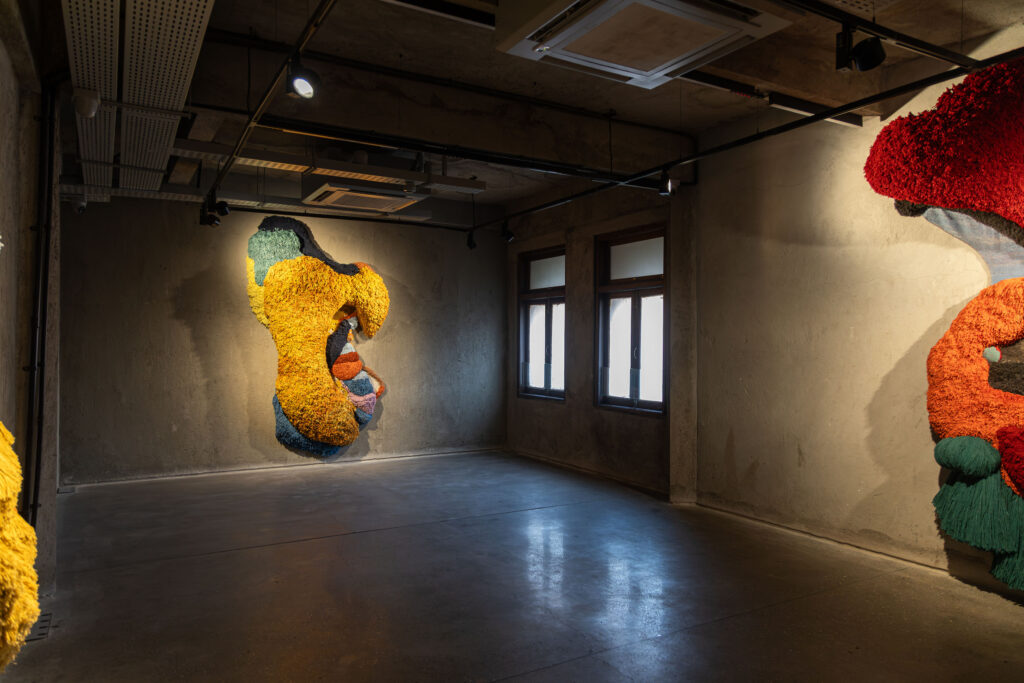
Lorenzo Vitturi (b. 1980, Venice, Italy) works in photography, sculpture, and installation. Following his experience as a cinema set painter, Vitturi builds temporary sets and ephemeral sculptures, in-studio and on location, using both organic and fabricated materials. Starting from specific geographical locations and encounters with local communities, his work explores informal economies and the merging of different cultures, focusing on the movement of objects and people in a globalised world. His recent solo exhibitions include Money Must Be Made at Fondazione MAST, Bologna, Italy; Nulla è Puro at Centre Photographique Rouen Normandie, Italy; Materia Impura at FOAM Museum, Amsterdam, Netherlands; Dalston Anatomy at The Photographers’ Gallery, London, at Contact Gallery, Toronto, and at CNA, Luxembourg. Vitturi also participated to group exhibitions at MAXXI in Rome, at Centre Georges Pompidou in Paris, at Palazzo Reale and La Triennale in Milan, at BOZAR in Brussels, at K11 Art Museum in Shanghai, and at Barbican Centre in London. Vitturi’s latest book Money Must Be Made was published by SPBH Editions in September 2017. He currently lives between Venice, Italy and London, UK.
The project has been realised in collaboration with Jaipur Rugs Foundation.
Text by Giulia Civardi
This exhibition will take place in Nature Morte’s Mumbai gallery space at 3rd Floor, Dhanraj Mahal, Apollo Bunder, Mumbai.
The hours are Monday through Saturday from 11am to 7pm and the gallery is closed on Sundays.
For more information on the artist or the works in the exhibition
please visit our website at www.naturemorte.com or contact us at info@naturemorte.com.
PREVIEW: March 23, 6–8pm
March 23–April 27 2024
“History Lab and the Elegy of Visceral Incantations,”

| The Kerala Lalithakala Akademi is thrilled to announce our third show in the retrospective artists series with the upcoming exhibition, titled “History Lab and the Elegy of Visceral Incantations,” which will showcase the remarkable paintings and sculptures of the renowned artist T V Santosh. Join us for the grand inauguration on May 1st, as the exhibition continues to captivate audiences until May 22nd at the prestigious Durbar Hall Art Gallery, Ernakulam. For further information and images please contact us at: theguildart@gmail.com, teamattheguild2@gmail.com |
| Copyright © The Guild and Kerala Lalithakala Akademi, 2024 | All rights reserved. The Guild – Mumbai (admn and viewing) 1/A, Pipewala Bldg. 4th Pasta Lane, S. B. S. Road, Colaba, Mumbai 400005 +91 022 2287 5839 /6211 The Guild – Alibaug 1028, Ranjanpada Next to Sai Temple, Mandwa Alibaug Road Alibaug – 402201 Hours: All days 10-6.30pm |
Padamsee’s years at the art school came at a time when a lot of undercurrents were passing through the Indian Art world
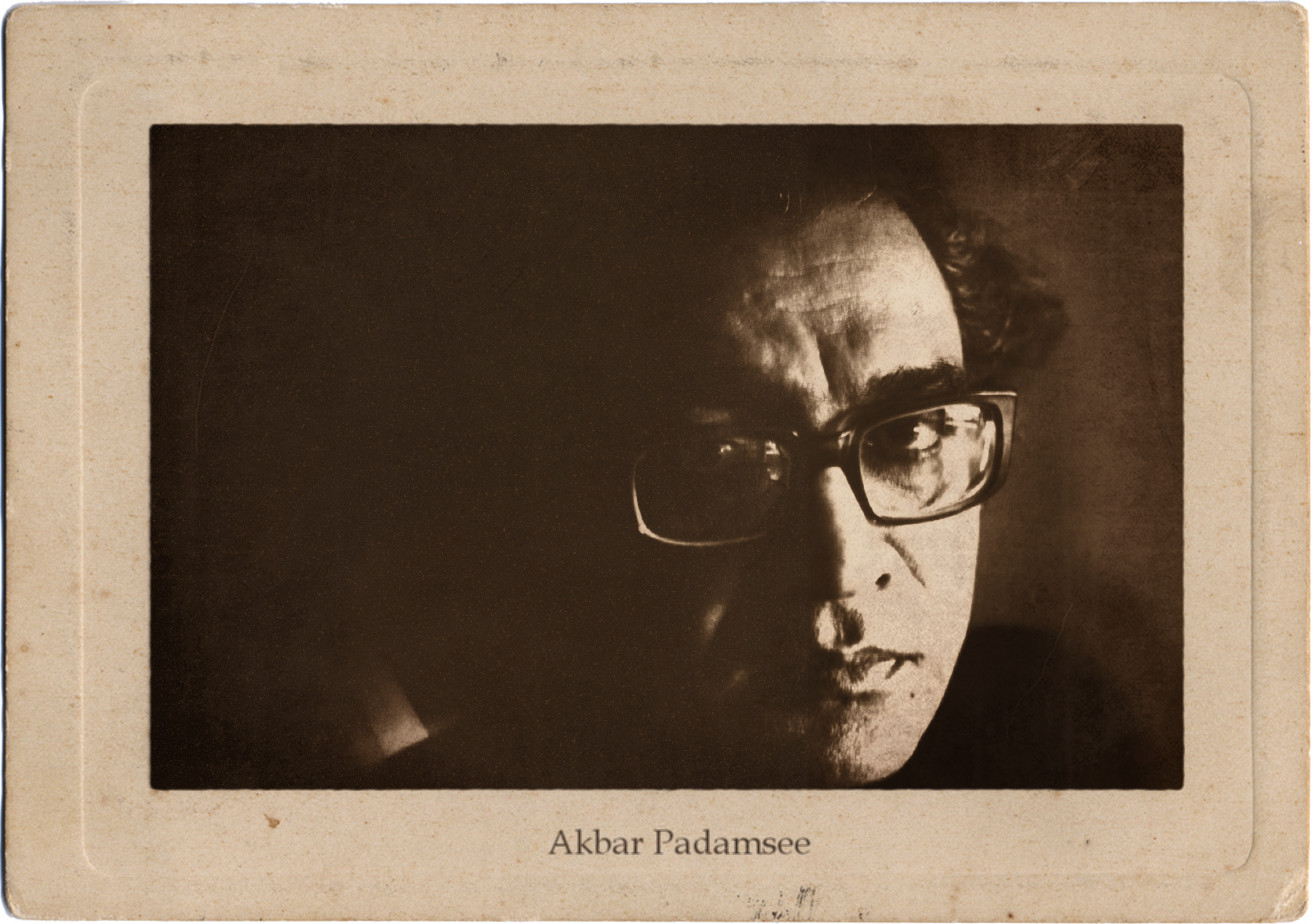
On 7th January 2020, the Governor of Maharashtra, Bhagat Singh Koshyari presented the first ‘Vasudeo Gaitonde Kala Jeevan Puraskar’ (Life Time Achievement Award in the Field of Art) to Late Akbar Padamsee (posthumously) at the 60th Maharashtra State Art Exhibition held at Jehangir Art Gallery. An evening earlier, Akbar Padamsee passed away at the Isha Yoga Center in Coimbatore. He was excited when he heard of receiving the award that was dedicated to him in the name of his artist friend Vasudeo Gaitonde who was his senior by few years at Sir J. J. School of Art.
Born on April 12, 1928, Padamsee’s ancestors hailed from Vāghnagar, a village in the Bhavnagar district of the erstwhile Kathiawar, now part of Gujarat. His grandfather was the sarpanch of the village and earned the title Padmashree or Padamsee after distributing his entire granary to the village during a famine. The family had belonged to Charana community, known as Deviputras (sons of the goddess). Charanas were essentially litterateurs and folklorist. Youngest amongst eight siblings, Akbar, as a child, stayed aloof and preferred to amuse himself with books. He also displayed an ardent interest in art that developed through photographs of gods and goddesses his nanny shared with him. The antique Irani furniture and flower vases that adorned his home also inspired him. At the age of four, he took to drawing in the margins of the account books and ledgers at his father’s shop of imported glass lanterns on Chakla Street, South Mumbai. In his primary school, he would draw caricatures on the black board before the class teacher would arrive, when the teacher would enquire, the classmates would point out to Padamsee, but she would never believe that such a young boy’s drawings had a mature finesse.

Akbar Padamsee
He was 11 years old when he accidentally stepped on a rusted nail, leading to a serious injury. While the wound was cured, the psychological impact left him speechless. It was more the will to speak that had gone away. Apparently, he did not speak a word for about nine years. Instead, he focused his energies on reading and art. After his father passed away, his elder brother Nicky (Nurudin), eight years his senior served as a father figure and gave him a book on Freud’s Introductory Lectures on psychoanalysis, dream interpretations and the psychopathology of everyday life. Not quite realizing what it was about, it was like tasting in advance what was going to come. Padamsee reciprocated with the writings of philosophers like Heidegger, Sartre and the likes; he believed that thinking was a system before one could paint. The influence of this can be seen in his later works. He chose to study at Sir J.J. School of Art, but Nicky advised him to join St. Xavier’s High School. At St. Xavier’s High School, Fort, he had a very strange school life. He was a back-bencher and day-dreamer who was always ridiculed by his classmates over his speech impediment. During school examinations, his elder brother helped him study, and somehow saved him from the kind of education that was doled out in those schools. Later, he met his first mentor, drawing teacher Shirsat, a water colourist, who tutored him in the medium, wines in Khandala, and nudes at a special class at Charni Road, in preparation for his studies at the Sir J. J. School of Art, enabling him to join the course directly in its third year.
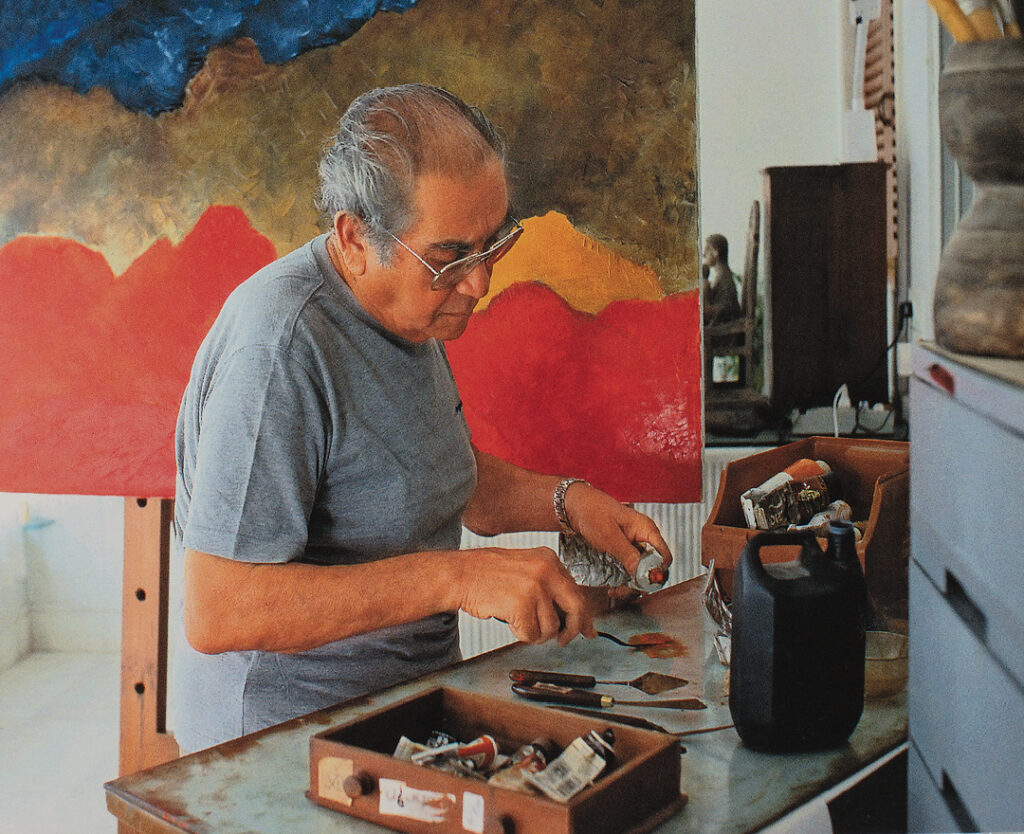
Padamsee’s years at the art school came at a time when a lot of undercurrents were passing through the Indian Art world, the most important being the formation of the Progressive Artist Group. He learned the academic style of painting that was popular in those times but did not restrict himself to just that. Even as a young adult, he enthusiastically learnt what was beyond the norm. He would skip classes and spend hours in the college library, pouring over books and acquainting himself with the work of the Masters. He was more interested in the science of art inspired by formal conundrums and conceptual schemes in approaching his work and would often investigate Durer’s drawings, Piero della Francesca’s studies for the curve of a queen’s neck – he had made a complex grid as if it were for a bridge. One day, he found T.A. Gopinath Rao’s Elements of Hindu Iconography in the library and was amazed by the precise directions that were given to the bronze sculptors. It was later at the school of art that he used the concept of the grid as geometry of proportion; however, it was at the elementary level. He also read a book on principles of Chinese painting. However, it was only later that he developed these ideas further .Of his early days spent at Sir J. J. School of Art, he once claimed: “In those days, learning painting in that tree-studded campus was a heady experience”. Professor Shankar Palshikar introduced him to miniature paintings and burnishing the surface with cowrie shell to spread the color evenly to get a glaze effect, but Padamsee would be lazy to do it all by himself. His early work during that year started with detailed study of heads, prophets and different couples. Padamsee’s subjects appeared astute with a pondering gaze. He disliked the sentimental and refused to submerge his figures with that feeling. This is why; even when he portrays his nude protagonists, they lack any outward sensuality. Padamsee studied French and his art teacher, Shankar Palsikar, encouraged him to study Sanskrit, which later became the basis of Padamsee’s thought process and the foundational structure for his art.

After his completing his diploma in painting, he took up sculpture for a year; one afternoon, when he was rhythmically beating the sheet metal with a hammer to make a relief sculpture. In the adjacent studio, another professor called Sabannavar, from the metal-craft department, was busy with his work. Suddenly, he barged into Padamsee’s space and asked him to stop work. The cause of the professor’s anger was the sound that the artist was producing while beating the sheet. He knew from the sound that Padamsee was doing something wrong. He asked Padamsee if he was disturbed, to which Padamsee replied with a yes. Padamsee was thus sensitized to the importance of sound in art-making. Later, he would apply this lesson an accidental insight to his pictorial practice. In an interview with Homi Bhabha, he recalls: “The professor’s interpretation intrigued me and I decided to experiment with sound. I took a very heavy aluminum holder in which I inserted a felt pen. I then dipped it in ink and started hitting on my drawing paper stretched on the board, really hard. Next, I tried this on my charcoal and oil works on canvas board and had a whole show around these works. I was going by the sound. Finally, an image would emerge, and it was often said that I painted with dots, but in reality I was painting with sound.”
Padamsee was a student associate, not a formal member, of the Progressive Artist Group, founded by F.N. Souza, with Raza and M.F. Husain as members, among others, with whom he developed a lifelong friendship. He along with Tyeb Mehta helped in installing works of the Progessives and other seniors like Mohan Samant. His father had a cyclostyle machine, with which he made copies of a catalogue of the show the Progressives had put up. That probably made him a blue-eyed boy. Later in 1948, an exhibition of paintings of student artists comprising of fifty artworks was organized by the Progressive Artist Group and was shown at the Bombay Art Society’s Salon. Francis Newton Souza, the then Secretary of the Progressive Artist Group said the exhibition was a novel idea and intended to draw attention of the public and art critics to the works of art students. Padamsee’s paintings were highly appreciated by the art critics.

In 1950, a former student visited the school of art and showed interest in the works of the students. The senior was S.H. Raza. Padamsee told Raza that he was given third-class. Raza said he should have gotten a first-class with this work. Raza had received a scholarship to go to Paris and offered to take him along. Padamsee shared the news with Palshikar, who said he should see India first; next Padamsee brought himself a ticket to Madurai and visited the Meenakshi temple. Later in 1951 along with Raza he sailed to France, where Padamsee met the surrealist Stanley Hayter and started painting at a local studio, Atelier 17, and held his first show at Galerie Saint Placide in 1952. His first exhibition in Paris, which required artists to stay anonymous, saw Padamsee sharing the prize awarded for it by the French Journal d’Arte with the surrealist Carzou, then in his 40s. Thus began a never ending journey of honours and awards. He was featured in the 1959 Tokyo Biennale, he received a gold medal from the Lalit Kala Akademi in 1962 A fellowship by the Rockefeller Foundation in New York followed in 1965, and in 1969 the prestigious Jawaharlal Nehru Fellowship, he was bestowed by Padma Bhushan and Kailash Lalit Kala award in 2010. His figurative works from the 1950s gave way to bronze heads the human expression was a lifelong preoccupation of Padamsee to photography. Exhibitions have been held at institutions worldwide, including the Rubin Museum of Art in New York and London’s Royal Academy of Art.

Padamsee always approached his art with deep thought and intense focus, constantly pushing boundaries and innovating in his creative process. During his illustrious career, Padamsee explored a wide range of mediums, and managed to remain fiercely experimental and individualistic. His artistic oeuvre is a formal exploration of a few chosen genres — prophets, heads, couples, still-life, grey works, metascapes, mirror-images and tertiaries, across a multitude of media oil painting, plastic emulsion, water colour, sculpture, printmaking, computer graphics, films and photography. His early portraits and landscapes in varied mediums of painting, drawing and etching demonstrate a quasi-spiritual style of working. His oils have been characterised by a deep intensity and luminescence while his drawings exude a serene grace.
Akbar Padamsee has always been eclectic, drawing his inspiration from various sources. He spoke at length about the western and eastern philosophy, be it Paul Klee’s The Thinking Eye or Mammata’s Kavyaprakasha. He was on board with anything that helped him give an adequate structure to his own art. Never one up for an easy summing up of art, his work continues to take the viewers through an intense journey unmasking the mysteries of art, through his work and life.
Quoting Padamsee’s favourite line from the Isa Upanishad, there’s formlessness about great poetry that moves you. Addressing the sun, the speaker says, ‘Remove the glare, so that I can look at you face-to-face because I’m the very person that’s yonder; I’m the sun myself. When the heat of the sun reaches me, let the body be reduced to ashes; but may the mind remember, remember, remember… Om shanti, shanti, shanti…’
Abhijeet Gondkar
February 2020, Mumbai

(Abhijeet Gondkar is an independent writer and curator based in Mumbai. The above extracts are from inputs by Bhanumati Padamsee, Jehangir Nicholson Art Foundation and further readings of Padamsee’s conversation with Homi Bhabha published by Marg. The above article was published as a tribute to Akbar Padamsee in ‘Roopa-Bheda’ 2019-20, an annual publication of Sir J.J. School of Art, Mumbai)
Art Blogazine 2024
Monday, 29 April 2024
"Every Picture has a story" An exhibition of Photographs by Kabeer Ramesh
 |
| Photographer Artist: Kabeer Ramesh |
Photo artist Kabeer Ramesh offers yet another solo exhibition titled ‘Every Picture has a story...’, the previous being ‘Frozen in Time’, which was held at the prestigious Jehangir Art Gallery, Mumbai. ‘Every Picture has a story...’, exhibited at the ‘Nitya Artists Centre’, Prabhadevi, from 1st May, 2024 onwards, grapples with, as the title suggests, human endeavours/stories in diverse and vivid contexts; these are photo-stories of promises and perils of being human: the glories and triumphs memorialised in monuments are juxtaposed with toiling workers in busy bazaar streets of Kolkata; the symbols of towering human achievements – the world famous the Taj Mahal and London Bridge - co-habit with the unease of forlorn ruins of the dilapidated and discarded. Interestingly, the idea of loners is presented in creatively imagined forms – the ‘lone stone’ of Shillong relentlessly standing up to vagaries of waters, and the unending wait of birds in summer of Rajasthan.
The trees presented in Kabeer Ramesh’s work too depict the diverse meaning universe: the erratic desires of the colonising human, and the falling humanity supported by dried branches of the uprooted. The exhibition also offers noteworthy studies in perspective - the broad-ways and the marvel of the Howrah bridge - what appears as meeting may be illusive, and what is near maybe far. The monuments in Kabeer’s work present an enigma: the famous Notre Dame cathedral in Paris lost its glorious treasures to the leaps of fire; so is the photograph of statue outside the Buckingham Palace, glorious yet stoic.
Kabeer Ramesh’s photographic imagery thus represents the indomitable human spirit, and also cautions against the unreasonable, erratic human desire to colonize. Importantly his works show that all human boundaries, all boundaries, are illusive, porous and imaginary. One could easily cross over the meaning universe and find multiple meanings through acts and ways of seeing and looking, in varied times and spaces.
Press Release From: 1st to 7th May 2024
Every Picture has a story... A Solo Show of Photo Art
By Kabeer Ramesh
VENUE: Nitya Artists Centre Gallery, 103, 1st Floor, Siddhi Vinayak Grandeur
Opp Ravindra Natya Mandir, Sayani Road, Prabhadevi, Mumbai 400 028
Contact: +91 9920072573 / kabeerphotoart.com
Friday, 26 April 2024
"Mediums of Enclosed Departures," at Ikko Gallery
In the vicinity of old working settelments of Sewri, art had seeped through in the form of black box, an art space created by Ar. Jasleen Changani with her mother Narinder Kaur Gilotra. A space that showcases contemporary art, which has no boundaries of space and painting both revolve around as well as complement each other. Currently is hosting a group exhibition "Mediums of Enclosed Departures," curated by the visionary Nilesh Kinkale, this showcase transcends conventional artistic boundaries.
Seven dynamic artists—Sadanand Shirke, Vinay Gusain, Ashish
Thakur, Rohit Varekar, Smita Kinkale, Riyas Komu, and Nilesh Kinkale. All of these artists deny using the traditional trio of
paint, brush and canvas insteade embrace an eclectic fusion of materials,
techniques, concepts, and themes.It's not just an art exhibition but a memory
that reminds of our presence, of the bygone era, our roots, a critical comment
on the present happenings.Through mesmerizing mediums each narrates a story of
itself, its environment.
.jpeg) |
| Ikko Gallery |
Artists like Rohit Varekar skillfully depict the
essence of their hometown by intertwining its heritage with personal
narratives. Varekar's use of wood as a medium transcends its physicality,
embodying collective memory and historical consciousness. He elegantly
incorporates elements such as wooden toys and ancestral wealth, turning wood
into a vessel that carries the essence of his region.
In contrast, artists such as
Ashish Thakur focus on the tactile
and olfactory qualities of soil, combined with organic materials, to comment on
rapid urbanization and environmental degradation. Thakur's work highlights the
sensory loss accompanying urban sprawl, urging a reconsideration of humanity's
relationship with the natural environment. By referencing cultural symbols like
the Ganpati tapestry, Thakur weaves together personal, environmental, and
cultural narratives in his art.
Smita Kinkale's
creations using polymer sheets serve as critical commentary on contemporary
issues and the loss of natural phenomena. Her work prompts viewers to reflect
on the impact of modern developments on the environment and society.
Sadanand Shirke offers visual narratives on Mumbai's changing urban landscape, capturing its vibrancy and frenetic pace through his use of vinyl and bright colors. However, beneath the surface, his work hints at a superficial, emotionless existence, inviting contemplation on the city's complexities.
Nilesh Kinkale's artworks often feature roads, symbolizing Mumbai's ubiquitous infrastructure. He views these roads not just as physical pathways but as integral parts of daily life, rich with the remnants of the city's history. Kinkale's paintings offer a nuanced perspective on urban transformation, exploring its impact on individual memories and shared cultural heritage.
The way that woodwork
of Riyas Komu engages with
political tales highlights the connections between political ideology, artistic
expression, and personal experience. Komu embodies the function of both witness
and commentator in art, as evidenced by his background and material selection,
which show a strong link to his cultural heritage and a commitment to political
discourse.
 |
| Artist: Riyas Komu |
The show
'Mediums of Enclosed Departures' is a testament to the enduring power of art to
capture diverse memories and portray individual environments. Through mesmerizing mediums and thought-provoking narratives,
the exhibition invites contemplation on the interplay between memory,
environment, and cultural heritage.
- News Text by Art Blogazine Team
IKKO Art Gallery Art gallery in Mumbai, Maharashtra
Address: 302, Satya House, Sriram Tekdi Rd, Sindhu Nagar, Sewri, Mumbai, Maharashtra 400015
“VEDAS AND BEYOND” Solo show of paintings by well-known artist Nita Desai in Jehangir
Nita Desai’s “Vedas and Beyond” - A Painting Exhibition Where Tradition Meets Modernity
 |
| Artist: Nita Desai |
We are thrilled to announce the upcoming solo exhibition of Nita Desai, an artist renowned for her unique blend of traditional techniques with contemporary themes. The exhibition, titled “Vedas and Beyond” will open its doors to the public from 29th April to May, 2024 at the Jehangir Art Gallery, Mumbai.
Nita Desai, a visionary in the art world, has garnered attention for her ability to harmonize the rich heritage of classical art with the dynamic pulse of modern thought. Her latest collection features a series of paintings that explore this duality, inviting viewers to a visual dialogue between the past and the present.
The exhibition will showcase over fifteen of Desai’s latest works, each telling a story that transcends time. Her use of vibrant colors and intricate patterns draws from the wellspring of traditional Indian art, while her subject matter – ranging from urban landscapes to abstract interpretations of modern life – reflects a keen awareness of contemporary society.
Her work is a testament to the enduring power of art to bridge cultures and epochs, Her paintings are not just visually stunning; they provoke thought and conversation about the world we live in and the roots we come from.
The opening reception will be held on 29th April from 6:00 PM to 9:00 PM, where art enthusiasts will have the opportunity to meet the artist herself. We invite you all to experience the depth and beauty of Nita Desai’s art. About Nita Desai Nita Desai is a Mumbai-based artist whose work has been exhibited internationally. With a background in fine arts and a passion for cultural history, Desai’s paintings are a celebration of her dual identity as a traditionalist and a modernist.
Press Release:
From: 29th April to 5th May 2024
“VEDAS AND BEYOND” / Solo show of paintings by well-known artist Nita Desai
VENUE:
Jehangir Art Gallery, 161-B, M.G. Road, Kala Ghoda, Mumbai 400 001, Timing: 11am to 7pm.
Sunday, 21 April 2024
E- Paper - PDF Release
Friday, 19 April 2024
Snowball: Threaded Visions: Contemporary Embroidery For A Sustainable Future

Creatively Embroidered by Milaaya Embroideries’’ Gayatri Khanna, Presented by MASH – Shalini Passi, Curated by Dr. Arshiya Lokhandwala,
Snowball Studios is delighted to host an extraordinary exhibition, “Threaded Visions,” from 3rd to 6th, April 2024, between 11 AM to 7 PM. This innovative showcase, creatively embroidered by Milaaya Embroideries by Gayatri Khanna, is presented by MASH – Shalini Passi and Curated by Dr. Arshiya Lokhandwala.
Following its successful debut at the India Art Fair ’24, “Threaded Visions” seamlessly weaves the intricate threads of Indian craft and art at Snowball Studios. This exhibition represents a pioneering convergence of couture embroideries and artistic expression, offering visitors a glimpse into a world where tradition meets art.
The masterpieces on display reflect the celebrated works of modern and contemporary artists, meticulously interpreted through couture embroidery techniques by Milaaya Embroideries. Each stitch not only breathes life into the artwork but also celebrates India’s rich tradition of craftsmanship.
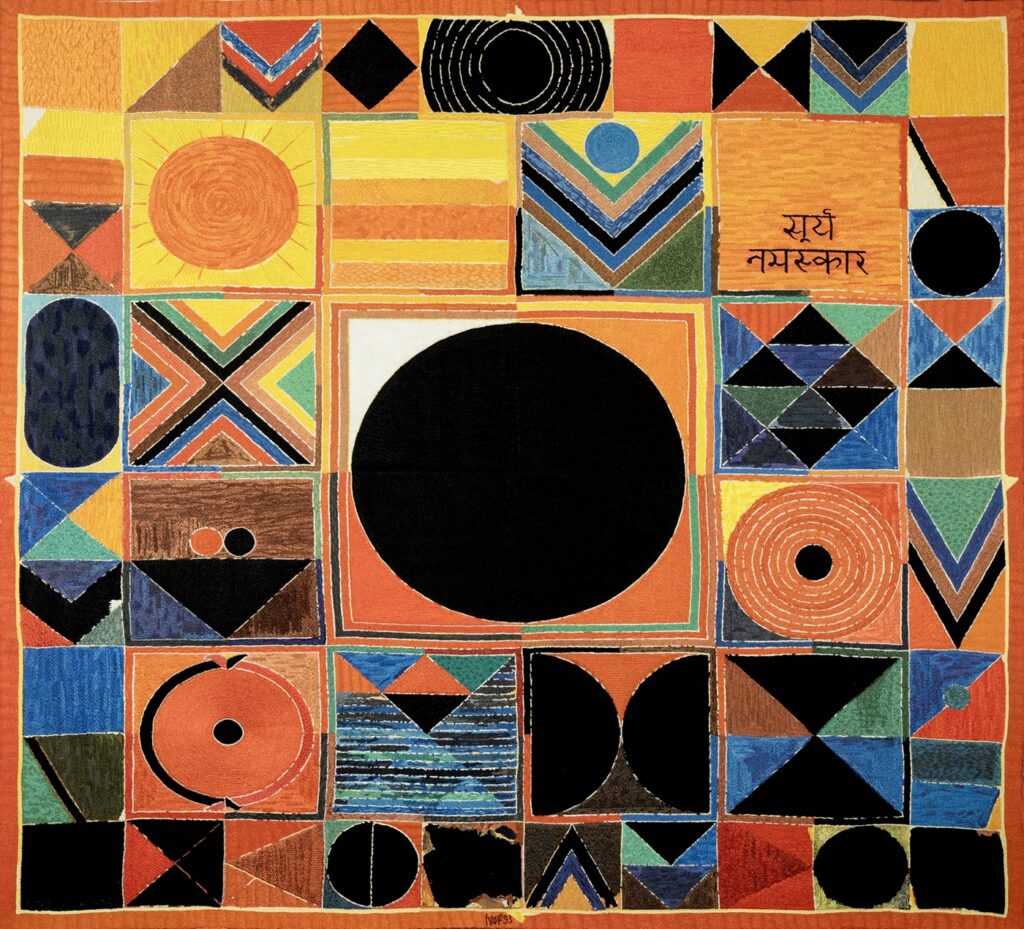
Renowned artists such as S H Raza, Gulam Mohammed Sheikh, Nilima Sheikh, Ranbir Kaleka, Ram Kumar, and K K Hebbar have their works featured in this unique exhibition with exclusive copyrights given to Milaaya Embroideries. Their art serves as a visual narrative, inviting contemplation on the delicate balance between nature and human existence.
“Threaded Visions” goes beyond the realm of artistry; it serves as a poignant commentary on sustainability and climate change. Through the embroidered interpretations of modern and contemporary artworks, the exhibition prompts viewers to reflect on ecological concerns and the urgent need for conservation.
Visitors will witness a diverse array of embroidery techniques, including Aari and Zardozi, Satin stitch, Phulkari, Kutch embroidery, Kantha stitch, and French Knots, among others. Each artwork intricately crafted by skilled artisans not only showcases the beauty of embroidery but also sparks meaningful conversations about our collective responsibility towards the planet.
“Threaded Visions” invites you to explore the interconnectedness between art, craft, and sustainability. Join us at Snowball Studios from 3rd to 6th April and embark on a journey that celebrates creativity while advocating for a more sustainable future.
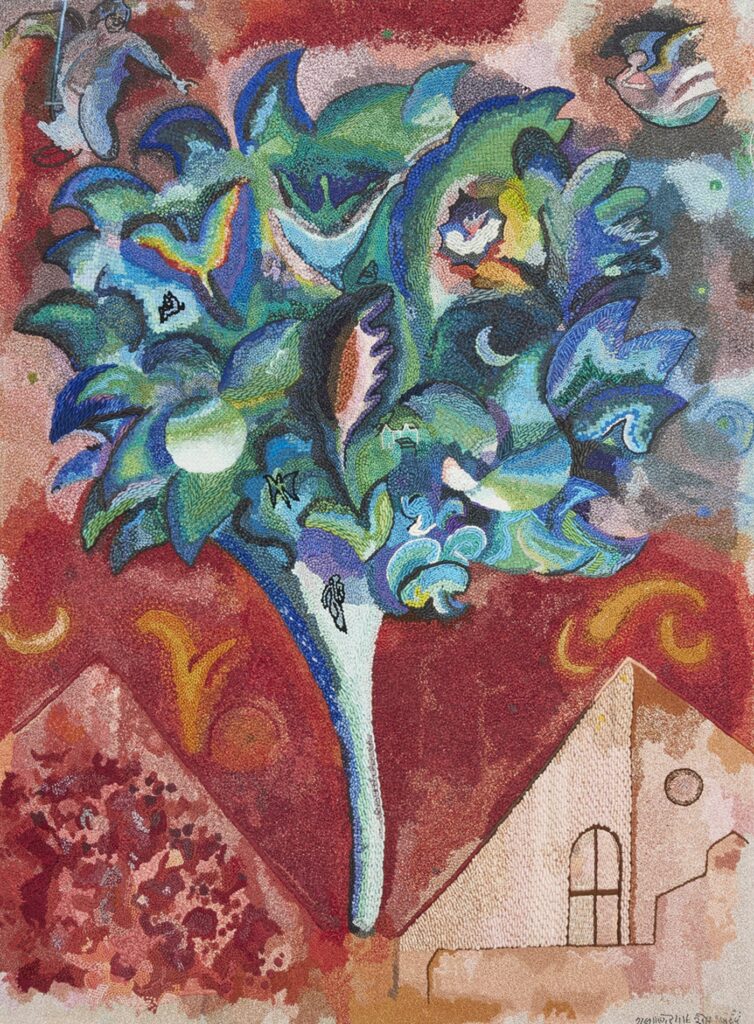
Milaaya Art Foundation Championing Artisan Empowerment and Community Development
Hand embroidery, a cherished tradition passed down through generations, faces modern challenges in today’s fast-paced world. Led by Gayatri Khanna, the foundation is committed to uplifting artisans and preserving cultural heritage by providing training in distinctive couture embroidery techniques.
Milaaya Art Foundation recognizes that empowering artisans goes beyond skill development; it opens doors to new opportunities in the world of art, creating a pathway for growth and self-expression. By equipping artisans with valuable skills, the foundation not only enhances their earning potential but also fosters a more enriching work environment, leading to improved living conditions and overall well-being.
Moreover, the foundation’s initiatives extend to community development, with a focus on establishing factories in or near artisans’ hometowns. By bringing employment opportunities closer to home, Milaaya encourages artisans to live in better conditions, fostering stronger family ties and community bonds.
Gayatri Khanna emphasizes the importance of collective action in preserving this dwindling trade. Milaaya Art Foundation welcomes collaboration from other organizations, recognizing that true impact requires a united effort that benefits the entire artisan community.
Through this significant initiative, Milaaya Art Foundation is not only safeguarding traditional craftsmanship but also building a brighter future for artisans and their communities.
Art blogazine
AstaGuru’s ‘Next Gen’ Auction Shines with Iconic Anish Kapoor Sculpture and Contemporary Masterpieces”
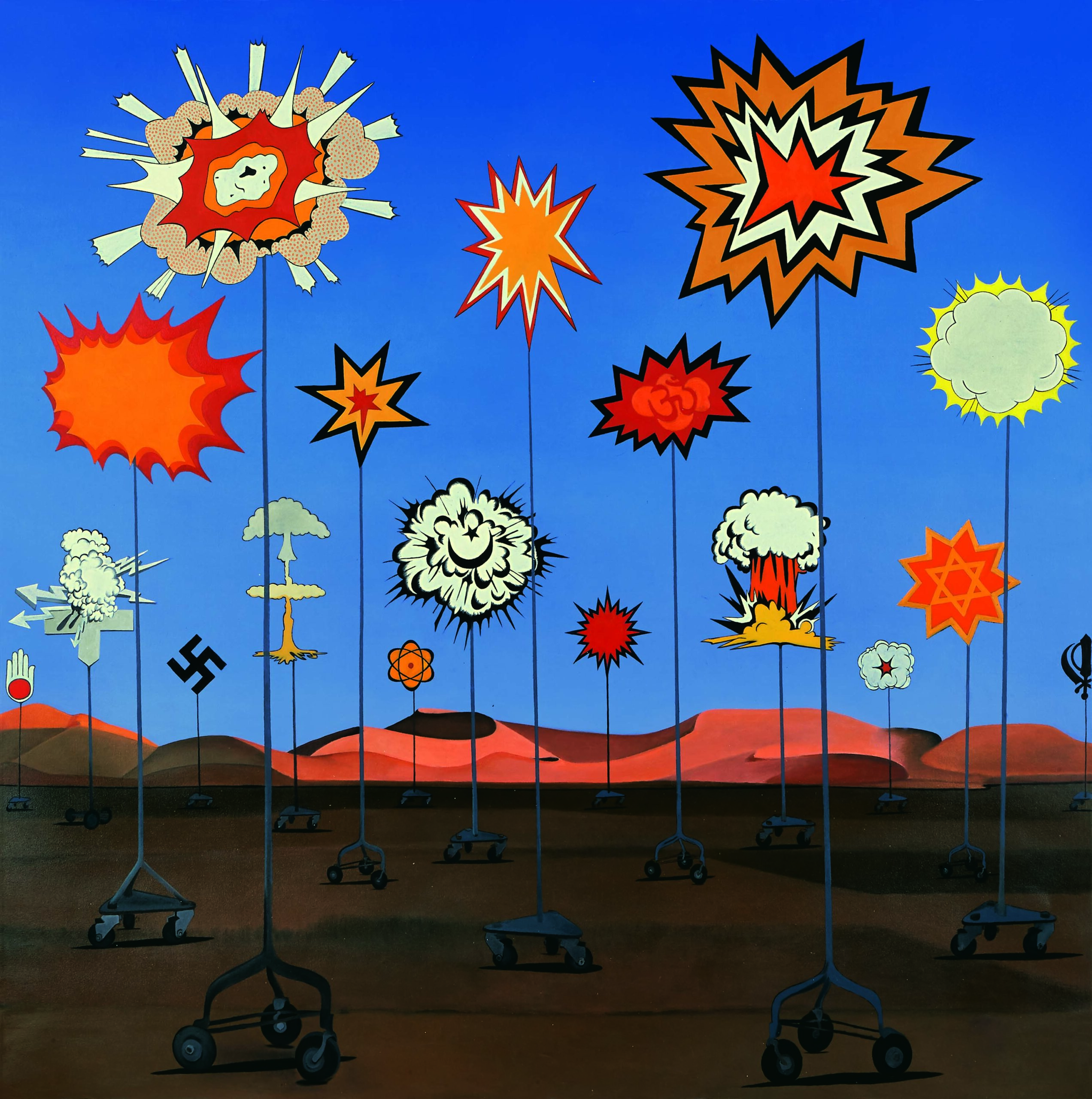
AstaGuru will present the next edition of its ‘Next Gen’ Contemporary Art Auction with over 100 works by leading and famous contemporary artists. The finely curated catalogue is led by an awe-inspiring creation by Anish Kapoor, executed in 2012. Lot no. 71 by Kapoor belongs to his vast oeuvre of mirror-like stainless steel discs that manipulate reflections, creating captivating distortions while providing a seamless view. This lot is estimated to sell at INR 5,00,00,000-7,00,00,000.
Works by eminent contemporary Indian artists such as Atul Dodiya, Subodh Gupta, Jitish Kallat, Nataraj Sharma, Valay Shende, Suryakant Lokhande, Ranbir Singh Kaleka, Surendran Nair, Bose Krishnamachari, Jagannath Panda, Baiju Parthan, Jayashree Chakravarty, Sheila Makhijani, G R Iranna and Sudhir Patwardhan will also be on offer. The auction is scheduled for April 8-9, 2024.
Commenting on the upcoming auction, Ankita Talreja, AVP at AstaGuru Auction House says, “This auction will be showcasing a diverse curation of works by both leading and upcoming artists in the contemporary Indian art space. These artists have been instrumental in voicing the passions and concerns of the current time, and reshaping how Indian art is seen today. Influenced by their cultural backgrounds and personal trials and tribulations, each work is a unique depiction of their artistic vision. Not only are these works diverse in subject matter, but also in styles, techniques and palettes. The unconventional and innovative nature of contemporary Indian art has found a growing base of collectors, both new and seasoned, looking to diversify their collections. We are proud to offer collectors a chance to acquire impressive sculptures and paintings from the oeuvres of the next generation of visionary artists. ”

Surendran Nair:
Lot no. 1, an oil on canvas work titled ‘Rainbows In Curved Air – Study For An Installation Elysium (Cuckoonebulopolis)’ by Surendran Nair was executed in 2010. The artist draws inspiration from political caricatures and cinema posters. His work seamlessly blends traditional and contemporary imagery while being rooted in surrealism. This lot is estimated to sell at INR 15,00,000-20,00,000.
Rana Begum:
Rana Begum’s Lot No. 8 titled ‘No. 679 – Fold’, executed with lacquer-coated steel in 2016, is an impressive example of her prowess in minimal abstraction and geometric constructions. She is best known for works that are an enigmatic interplay of light, colour and shapes on surfaces. This is estimated at INR 15,00,000-20,00,000.
Prithpal Singh Ladi:
Lot No. 15 is an untitled creation by Prithpal Singh Ladi. Executed with fibreglass, aluminium, rope, glass, wood, and paint, the sculpture showcases Ladi’s penchant for the unconventional, as he effortlessly transitions between the mundane and the fantastical. The lot will be offered at an estimate of INR 20,00,000-30,00,000.
Shilo Shiv Suleman:
Titled ‘Separation (The Magician)’, Lot No. 16 by Shilo Shiv Suleman is a unique display of magical realism. The acrylic on canvas executed in 2022 showcases Suleman’s fascination with the female form and nature. This lot is estimated at INR 8,00,000-10,00,000.

Atul Dodiya:
Lot No. 29 titled ‘Stammer In The Shade – VIII’ is a sculpture executed with acrylic, marble dust, iron crutches, iron brackets & gold leaf by artist Atul Dodiya. Executed in 2005, the presented lot will be offered at an estimate of INR 20,00,000-30,00,000.
Valay Shende:
Lot No. 36, a sculpture titled ‘Girl With Balloons (ED: 2APS+8)’ by eminent sculptor Valay Shende, is executed using his signature medium – coated & painted stainless steel discs. The presented lot serves as an ode to children often seen selling ephemera, such as balloons in this instance on the road. It will be offered at an estimate of INR 10,00,000-15,00,000.
Sheila Makhijani:
Titled ‘Peachy Peach Leachy Leach’, Lot no. 43 is an acrylic on canvas by Sheila Makhijani, created in the year 2002. The intense display of movement through soft and dark colour tones adds a unique and nuanced take on her intricate geometry. This lot is estimated to sell at INR 15,00,00,000-20,00,000.

Nataraj Sharma:
Lot No. 64 titled, ‘Tailor Ahmed 6th Main 36th Cross’ is an oil on canvas by Nataraj Sharma. His canvases, imbued with both wit and introspection, delve into the ramifications of swiftly evolving urban landscapes. Employing a complex interplay of visual elements— memories, sweeping vistas, technology, intricate imagery, and the natural world—Sharma crafts a distinctive visual dialect that infuses familiar imagery with fresh connotations. This lot is estimated at INR 30,00,000-40,00,000.
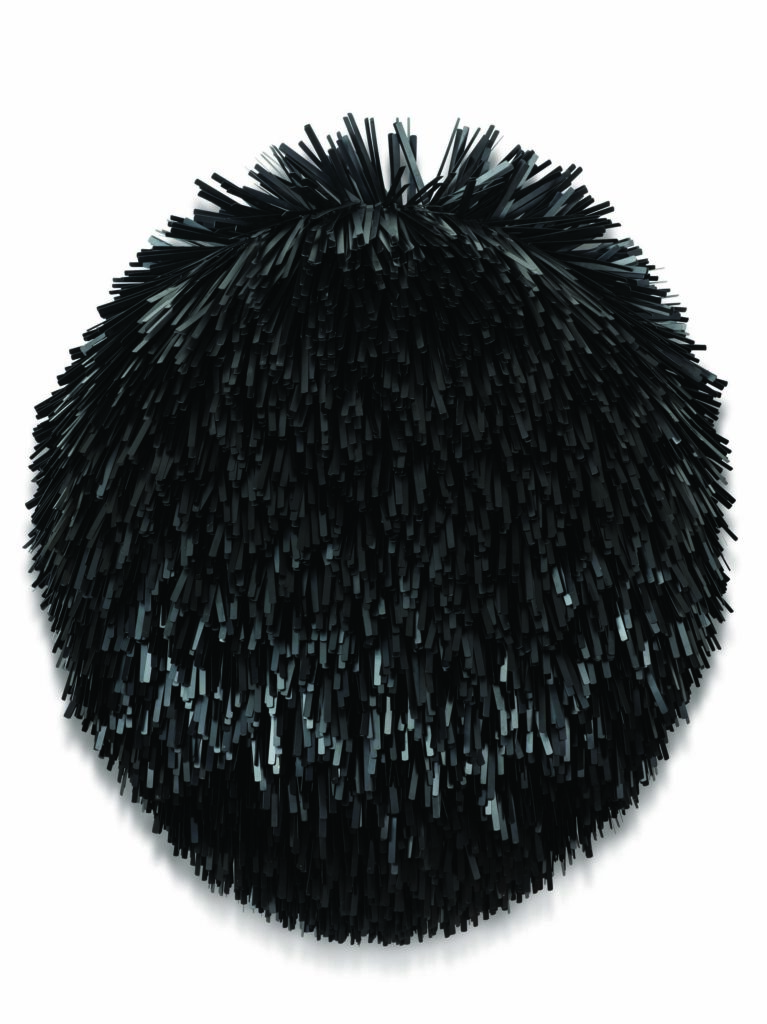
Subodh Gupta:
Lot No. 103 titled ‘Black Thing (Ed:1/3)’ is a large-scale sculpture by Subodh Gupta executed using steel structure, plastic and painted stainless steel pincers. The presented lot, created in 2007, showcases Gupta’s artistic vision and preoccupation with monumental works utilising objects seen in daily life. This lot is estimated at a value of INR 60,00,000-80,00,000.
Thukral & Tagra:
Lot No. 118 is an untitled oil on canvas by Thukral & Tagra. The duo’s work is characterised by vibrant imagery and exuberant colours, featuring everyday objects like cameras and alarm clocks alongside people, flora and fauna. This lot will be offered at an estimate of INR 10,00,000-15,00,000.
An analysis of the auction results can be viewed on www.astaguru.com.
All figures include margin amt.
About AstaGuru
AstaGuru Auction House was conceptualised in the year 2008 with the sole purpose of creating a safe and secure platform to conduct online auctions for Contemporary & Modern Indian Art. Over the years, AstaGuru has curated auctions encompassing diverse categories, our portfolio includes art, jewellery, fine silver, timepieces, textiles, celebrity memorabilia, rare books, numismatic, philately and vintage cars. In 2018, AstaGuru became the first Indian auction house to present an exclusive edition for vintage and classic cars. “AstaGuru has strived to successfully bridge the gap between prospective buyers and consignors by transcending the limitations of live auctions. AstaGuru imparts effortless transparency to the process of acquiring and selling art and rare collectibles. The online module offers bidders the opportunity to bid from the comfort of their houses or while they are on the go.
For more information, please log on to https://www.astaguru.com/
Facebook: @Astaguru | Instagram: @astaguru | X: @astagurutweets





.jpeg)




